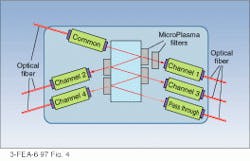Filters create thermally stable, passive multiplexers
Filters create thermally stable, passive multiplexers
Thermally stable thin-film filters and low-loss design yields 16- and 32-channel multiplexers for dense-wavelength- division-multiplexing applications.
Michael A. Scobey, Walter J. Lekki, and Thomas W. Geyer
To meet the capacity demands on fiberoptic telecommunications systems, many network designers are turning to wavelength-division-multiplexing (WDM) techniques in which multiple signals at closely spaced wavelengths, or channels, are sent simultaneously over the same fiber. This technique effectively increases the capacity of the transmission line by the number of channels. In transmission demonstrations, high-channel-count WDM systems have achieved terabit-per-second data rates--enough, for example, to transmit all the data on thousands of personal-computer hard drives over a single fiber in one second.
While typical commercially available WDM configurations offer four to eight channels, future systems will need to operate at 16 or 32 channels per fiber, with all channels squeezed into the narrow (approximately 30 nm wide) spectral window of erbium-doped fiber amplifiers (EDFAs). As a result, WDM component manufacturers are facing new challenges to develo¥components capable of multiplexing and demultiplexing ever greater numbers of channels with minimum loss, crosstalk, and temperature sensitivity, while maintaining telecommunication standards for reliability.
Multiplexer filtering techniques
The three filtering technologies currently used to produce narrowband or densely channel-spaced wavelength division multiplexers are planar phased-array waveguides (PAWs), fiber Bragg gratings, and thin-film dielectric interference filters. Planar-phased-array-waveguide devices are typically composed of a thin silica layer grown on a silicon substrate, then etched to form waveguides with unequal pathlengths, connecting two slab star couplers. A common waveguide connects to one slab coupler, and a series of output waveguides connect to the other slab coupler. The device acts as a grating that directs individual spectral channels to the output waveguides.
Because the PAW is an integrated optic, it can be manufactured using potentially low-cost, high-throughput photolithographic techniques. However, these waveguides can typically introduce large polarization-dependent losses and large insertion losses. The spectral profile of the passband is also rounded unless a flattening scheme is used, which introduces additional loss. Finally, the coefficients of thermal variation are 10 to 15 pm/°C, which is too high for passive operation, leading to the requirement for temperature control.
Fiber Bragg gratings are an all-fiberoptic approach to multiplexing. A periodic refractive-index variation written into the core of a photosensitive optical fiber forms a spectral notch filter. The grating is intrinsic to the fiber, is easy to splice, and offers low insertion loss and good spectral profiles. Such fiber gratings, however, are fundamentally two-port devices and in practice must be combined with some sort of cascading device such as an optical circulator or 50/50 (3-dB) fiber coupler. These cascading devices are typically expensive, introduce significant insertion losses, and have debatable environmental stability.
Thin-film interference filters are simple, easy-to-construct components for widely spaced WDM multiplexers. These filters consist of a stack of dielectric thin films of alternating high and low refractive index. The optical thickness (physical thickness multiplied by the refractive index) of each layer is typically an integral number of quarter-waves; for tele communications wavelengths, this corresponds to a physical thickness of 0.25 µm or less. The order and thickness of the individual films can be tailored to produce almost any spectral profile, for example, yielding components functioning as bandpass filters, notch filters, or edge filters.
Thin-film filters
Optical interference filters are relatively easy to manufacture in quantity, offer good optical performance, and are easily packaged into fiberoptic devices. Until recently, however, the filters have suffered from poor temperature stability, and manufacturers have been unable to produce filters sufficiently narrow to demultiplex WDM channel spacings smaller than 4 nm.
The coating materials commonly used in thin-film filters for multiplexers--zinc sulfide, zinc selenide, or cryolite (Na3AlF6)--are hygroscopic, absorbing moisture readily and requiring environmental isolation with an epoxy-cemented cover slip. The materials also suffer from excessive scatter and absorption losses. Because these devices were inexpensive to manufacture and offered sufficient optical quality for WDM networks with widely spaced channels, however, they became an early industry standard. Researchers attempted to produce a more durable and rugged filter by evaporative growth of hard oxide films, but these filters suffered from a porous and columnar structure that led to large wavelength shifts in humid conditions.
To solve the porosity problems with hard oxide evaporated films, Optical Corporation of America (OCA; Marlborough, MA) developed the patented MicroPlasma coating process, based on deposition with energetic plasmas. The technique produces refractory metal-oxide thin films with bulk density and low optical loss, using a high-power, low-pressure reactive sputtering technique.1 The bulk density of the films produced, as well as their low optical scatter and absorption, makes them ideal for narrow-bandpass filters.
To improve the thermal stability of the filters, materials with low coefficients of thermal expansion and low refractive-index variation as a function of temperature were selected. Typical filters shift less than 0.5 pm/°C (see Fig. 1), sufficient to allow the components to be used in a passive or nontemperature-controlled mode for even the narrowest applications such as the emerging International Telecommunications Union standard of 0.8-nm channel spacing (100-GH¥grid).
Using these thin-film filters, OCA has produced multiplexers of 16 channels or more for dense WDM applications (see photo, p. 111). The devices are based on a Fabry-Perot resonant-cavity design. Each filter cavity consists of a dielectric spacer, whose thickness is an integral number of half-waves, separating two dielectric reflecting stacks composed of alternating layers of high- and low-index materials, each of quarter-wave optical thickness. The cavity filter transmits wavelengths for which the optical thickness of the total structure corresponds to an integral number of half-waves.
Filters for dense WDM multiplexers
The "squareness" or figure of merit (FOM) of a filter is defined by dividing bandwidth at the "top" of the filter by bandwidth near the "bottom," for example, dividing the 1.0-dB bandwidth by the 20-dB bandwidth. The FOM for an ideal filter would be equal to unity. Designers can widen the spectral to¥of the filter and steepen the slopes to improve the FOM by cascading two or more cavities on a common substrate using a quarter-wave coupling layer; typical DWDM designs use three to five cavities (see Fig. 2).
The basic filter-based multiplexer consists of a single filter with three ports: a main trunk line input, an output, and a dro¥port. Lenses collimate the diverging light from the fiber and direct it to the filter, then re-image the collimated light back into the fiber. The packaged device, sometimes called a three-port channel add/dro¥wavelength division multiplexer, can be cascaded to form a multichannel device by connecting or splicing the output of a three-port multiplexer to the input of a second multiplexer. The number of multiplexers in the cascade indicates the number of channels. Cumulative insertion loss and loss variation with temperature effectively limits this technique to eight channels or fewer before these values rise above acceptable limits.
To produce a 16-channel multiplexer, OCA designers took a different approach, using a miniature optical bench to relay light between filters (see Fig. 3). Light from an input or common fiber is collimated by a lens directed at a slight angle toward a filter block, with filters mounted on parallel sides. The beam undergoes multiple reflections from the filter input faces, and, at each reflection, one wavelength is removed. For multiplexing operations, the process is simply reversed--input from the individual channels enters the filter block and propagates through to the common fiber. The design also can be extended to 32 channels, and 50-GH¥channel spacings are realizable.
An advantage of this approach is that collimators are used only when the signal propagates through a filter, eliminating the cumulative effect of insertion loss experienced by the cascaded three-port designs. In addition, the total number of collimator assemblies is reduced, which decreases material costs as well as alignment costs. Finally, all channels have nearly the same low insertion loss as well as low insertion-loss variation with temperature.
Five-axis, micrometer-based equipment aligns fibers and collimators to displacement accuracies of less than 10 µm and angular accuracies of less than 1 arcmin. By monitoring device throughput with power meters, the positions of the fiber are optimized to minimize insertion losses. The total budget for insertion loss in fiber-to-fiber coupling for a wavelength division multiplexer is typically 0.5 dB, or about 90% transmission.
Interference filters are angle-sensitive, so the angle of the filter or filter block is critical to device performance. This is determined by measuring the center wavelength of the filter during the common collimator alignment using an optical spectrum analyzer (Hewlett-Packard, Santa Rosa, CA), in conjunction with a computer-controlled wavemeter and a tunable laser. The filters are typically assembled to provide wavelength accuracies of less than 50 pm.
As channel numbers increase and DWDM systems are applied to applications closer to local access, new requirements will arise. For lower-density, short-haul traffic, all-optical passive multiplexing provides a simple, reliable, and economical method for directing lower speed channels, rather than electronically demultiplexing low speed channels onto a high-speed channel using time division multiplexing techniques. By turning to WDM technology and incorporating photonic devices more deeply into telecommunications networks, the terahert¥potential of fiberoptic systems may finally be realized. o
REFERENCE
1. MicroPlasma, US Pat. #5,525,199, Low pressure reactive magnetron sputtering apparatus and method (June 1996).
Component for dense-wavelength-division-multiplexing operations uses passive, thermally stable thin film filters to multiplex 16 channels of data.
FIGURE 1. MicroPlasma filters offer thermally induced wavelength shifts of less than 0.5 pm/°C over a wide range.
FIGURE 2. Cascading several cavities on a single substrate improves filter bandpass shape (top). Detail of main plot (bottom) emphasizes the performance improvement gained by shifting to even three cavities.
FIGURE 3. In 16-channel multiplexer, like this four-channel design, collimated light at a slight angle from the normal enters the filter block, where it undergoes multiple reflections from the filter input faces. At each reflection, one wavelength is removed. The approach eliminates cumulative insertion loss experienced by conventional designs.




